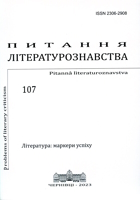Використання прийому «стирання» в молодій американській поезії початку ХХІ ст.: архітектонічно-структурна трансформація сонетного канону
Use of “Erase” Technique in Young American Poetry of the Early 21st Century: Architectonic and Structural Transformation of the Sonnet Canon
Author(s): Oleksandr Volkovynskyi, Serhiy HnatenkoSubject(s): Language and Literature Studies, Studies of Literature, Theory of Literature, American Literature
Published by: Чернівецький національний університет імені Юрія Федьковича
Keywords: architectonics; “erasure” technique; sonnet; structure; Ronald Johnson; Jen Berwin;
Summary/Abstract: “Erasure” technique has gained particular popularity in young American poetry of the early 21st century. Its use entails partial deletion or discoloration of the earlier text by a famous writer. Only fragments of the precedent text remain, used to subsequently shape a different architectonic and semantic structure. Shakespeare’s sonnets are an attractive object for “erasure”. They are the primary source for “innovations” by the poet and artist Jen Bervin in her book “Nets” (2003), the title of which is “erased” from the very word “sonnets” – “nets”. From partially discolored but readable Shakespeare’s text Bervin handpicks the words, extremely important to generate her new meaning. Architectonically, these words remain in the same places as in Shakespeare’s sonnets. Thus, the canonical sonnet form serves only as a background for laconic modernized expression. By means of “erasure” Bervin bares the Shakespeare’s sonnets’ deep semantic “grid”, actualizing various intertextual nuances. The poetic invariant opens up for new interpretations. Moreover, “erasure” technique has a purely technical component, hence the canonical form of the sonnet is subjected to certain filtering. The author of the new text produces numerous contemporary meanings. Therefore, “erasure” technique becomes an effective means of actualizing precedent texts. Modern reader oftentimes has already lost interest in them, but thanks to the postmodern experiment, expressive and sometimes brilliant new creations appear in the form of text fragments. Gamification, inherent to “erasure”, renews communicative processes, involving the classical author, their text, the experimental author, and their new work, as well as the recipient, also able to find new options for constructing utterances.
Journal: Питання літературознавства
- Issue Year: 2023
- Issue No: 107
- Page Range: 30-42
- Page Count: 13
- Language: Ukrainian

